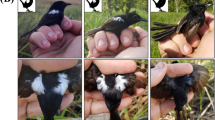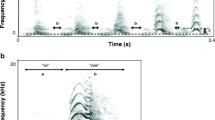Abstract
Many species possess multiple sexually dimorphic traits, which incorporate different sensory modalities (e.g., acoustic, olfactory and visual), although their relative roles in sexual selection and in determining reproductive success are still poorly understood for most taxa. We assessed the role of multiple male traits, including one acoustic (dominant call frequency) and one visual (yellow throat patch) trait, in residency advertisement, contest behavior, and breeding success in barking geckos (Ptenopus garrulus garrulus). We show that male barking geckos maintain largely exclusive home ranges, with a trend for larger males to maintain larger home ranges. We also show that larger males have a lower dominant calling frequency. When aggressive behavior was elicited in the field using a recorded call of average frequency, resident males with low frequency calls were more likely to respond aggressively and charge the speaker compared to males with high frequency calls. However, body size and small relative throat patch size, rather than call frequency, were the best predictors of overall aggressiveness. Body size was also the best predictor of whether males bred. We suggest that call frequency in this crepuscular species constitutes an effective long-range signal of body size, used by males for remote rival assessment and to advertise home range boundaries in low-light environments.



Similar content being viewed by others
References
Abell AJ (1998) Male–female spacing patterns in the lizard, Sceloporus virgatus. Amphib Reptil 20:185–194
Anderson RA, Vitt LJ (1990) Sexual selection versus alternative causes of sexual dimorphism in teiid lizards. Oecologia 84:145–157
Barki A, Harpaz S, Karplus I (1997) Contradictory asymmetries in body and weapon size, and assessment in fighting male prawns, Macrobrachium rosenbergii. Aggress Behav 23:81–91
Berglund A, Bisazza A, Pilastro, A (1996) Armaments and ornaments: an evolutionary explanation of traits of dual utility. Biol J Linn Soc 58:385–399
Candolin U, Voigt H-R (2001) Correlation between male size and territory quality: consequence of male competition or predation susceptibility? Oikos 95:225–230
Censky EJ (1995) Mating strategy and reproductive success in the Teiid lizard, Ameiva plei. Behaviour 132:529–557
Civantos E (2000) Home-range ecology, aggressive behaviour, and survival in juvenile lizards, Psammodromus algirus. Can J Zool 78:1681-1685
Cooper WE Jr, Vitt LJ (1993) Female mate choice of large male broad-headed skinks. Anim Behav 45:683–693
Cox RM, John-Alder HB (2005) Testosterone has opposite effects on male growth in lizards (Sceloporus spp.) with opposite patterns of sexual size dimorphism. J Exp Biol 208:4679–4687
Díaz-Uriarte R (2001) Territorial intrusion risk and anti-predator behavior: a mathematical model. Proc R Soc Lond B 268:1165–1173
Elias DO, Hebets EA, Hoy RR (2006) Female preference for complex/novel signals in a spider. Behav Ecol 17:765–771
Frankenberg E (1982) Vocal behavior of the mediterranean house gecko Hemidactylus turcicus. Copeia 1982:770–775
Gerhardt HC, Huber F (2002) Acoustic communication in insects and anurans. University of Chicago Press, Chicago
Haacke WD (1969) The call of the barking geckos. Scient Pap Namib Desert Res Stn 46:83–93
Haacke WD (1975) The burrowing geckos of Southern Africa, 1 (Reptilia: Gekkonidae). Ann Transvaal Mus 29:198–243
Hebets EA, Papaj DR (2005) Complex signal function: developing a framework of testable hypotheses. Behav Ecol Sociobiol 57:197–214
Hews DK (1993) Food resources affect female distribution and male mating opportunities in the iguanian lizard Uta palmeri. Anim Behav 46:279–291
Hibbitts TJ (2006) Ecology and sexual selection of the common barking gecko (Ptenopus garrulus). PhD Thesis, University of the Witwatersrand, Johannesburg, South Africa
Hibbitts TJ, Pianka ER, Huey RB, Whiting MJ (2005) Ecology of the common barking gecko (Ptenopus garrulus) in southern Africa. J Herpetol 39:509–515
Huntingford FA, Turner AK, Sneddon L, Neat FC (2000) Prowess and the resolution of animal fights. In: Epsmark Y, Amundsen T, Rosenqvist G (eds) Animal signals: signalling and signal design in animal communication. Tapir, Trondheim, Norway pp 415–427
Johnstone RA (1996) Multiple displays in animal communications: ‘backup signals’ and ‘multiple messages’. Phil Trans R Soc Lond B 351:329–338
Kwiatkowski MA, Sullivan BK (2002) Geographic variation in sexual selection among populations of an Iguanid lizard, Sauromalus obesus (=ater). Evolution 56:2030–2051
LeBas NR, Marshall NJ (2001) No evidence of female choice for a condition-dependent trait in the Agamid lizard, Ctenophorus ornatus. Behaviour 138:965–980
Leiser JK, Gagliardi JL, Itzkowitz M (2004) Does size matter? Assessment and fighting in small and large size-matched pairs of adult male convict cichlids. J Fish Biol 64:1339–1350
López P, Munoz A, Martín J (2002) Symmetry, male dominance and female mate preferences in the Iberian rock lizard, Lacerta monticola. Behav Ecol Sociobiol 52:342–347
Manley GA (1990) The hearing of geckos. Peripheral hearing mechanisms in reptiles and birds. Springer, Berlin Heidelberg New York, pp 151–164
Marcellini DL (1974) Acoustic behavior of the gekkonid lizard, Hemidactylus frenatus. Herpetologica 30:44–52
Marcellini DL (1978) The acoustic behavior of lizards. In: Greenberg N, MacLean PD (eds) Behavior and neurology of lizards. Rockville, MD, pp 253–267
Martín J, López P (2000) Chemoreception, symmetry and mate choice in lizards. Proc R Soc Lond B 267:1265–1269
Maynard Smith J, Harper D (2003) Animal signals. Oxford University Press, New York
Maynard Smith J, Parker GA (1976) The logic of asymmetric contests. Anim Behav 24:159–175
McCauley SJ, Bouchard SS, Farina BJ, Isvaran K, Quader S, Wood DW, St. Mary, CM (2000) Energetic dynamics and anuran breeding phenology: insights from a dynamic game. Behav Ecol 11:429–436
Møller AP, Pomiankowski A (1993) Why have birds got multiple sexual ornaments? Behav Ecol Sociobiol 32:167–176
Olsson M (1992) Contest success in relation to size and residency in male sand lizards, Lacerta agilis. Anim Behav 44:386–388
Olsson M (2001) No female mate choice in Mallee dragon lizards, Ctenophorus fordi. Evol Ecol 15:129–141
Olsson M, Shine R, Gullberg A, Madsen T, Tegelström H (1996) Sperm selection by females. Nature 383:585
Olsson M, Madsen T, Nordby J (2003) Major histocompatibility complex and mate choice in sand lizards. Proc R Soc Lond B 270(suppl):S254–S256
Ord TJ, Blumstein DT, Evans CS (2002) Ecology and signal evolution in lizards. Biol J Linn Soc 77:127–148
Partan S, Yelda S, Price V, Shimizu T (2005) Female pigeons, Columba livia, respond to multisensory audio/video playbacks of male courtship behaviour. Anim Behav 70:957–966
Parker GA (1974) Assessment strategy and the evolution of fighting behaviour. J Theor Biol 47:223–243
Polakow DA (1997) Communication and sexual selection in the barking gecko (Ptenopus kochi) M.Sc thesis. University of Cape Town, South Africa
Pough FH, Magnusson WE, Ryan MJ, Taigen TL, Wells KD (1992) Behavioral energetics. In: Feder ME, Berggren WW (eds) Environmental physiology of the anurans. University of Chicago Press, Chicago, pp 395–436
Regalado R (2003) Roles of visual, acoustic, and chemical signals in the social interactions of the tropical house gecko (Hemidactylus mabouia). Carib J Sci 39:307–320
Rose B (1982) Lizard home ranges: methodology and functions. J Herpetol 16:253–269
Rubolini D, Romano M, Marinelli R, Leoni B, Saino N (2006) Effects of prenatal yolk androgens on armaments and ornaments of the ring-necked pheasant. Behav Ecol Sociobiol 59:549–560
Ruby DE (1981) Phenotypic correlates of male reproductive success in the lizard, Sceloporus jarrovi. In: Alexander RD, Tinkle DW (eds) Natural selection and social behavior: recent research and new theory. Chiron Press, New York, pp 96–107
Salvador A, Veiga JP (2001) Male traits and pairing success in the lizard Psammodromus algirus. Herpetologica 57:77–86
Smith GR (1995) Home range size, overlap, and individual growth in the lizard, Sceloporus virgatus. Acta Oecol 16:413–421
Stamps JA (1977) Social behavior and spacing patterns in lizards. In: Gans C, Tinkle DW (eds) Biology of the reptilia, vol 7. Ecology and behavior. Academic, New York, pp 265–334
Stamps JA (1983) Sexual selection, sexual dimorphism, and territoriality. In: Huey RB, Pianka ER, Schoener TW (eds) Lizard ecology: studies of a model organism. Harvard University Press, Cambridge, pp 169–204
Stamps JA, Krishnan VV (1998) Territory acquisition in lizards. IV. Obtaining high status and exclusive home ranges. Anim Behav 55:461–472
Tang Y, Zhuang L, Wang Z (2001) Advertisement call and their relation to reproductive cycles in Gekko gecko (Reptilia, Lacertilia). Copeia 2001:248–253
Tokarz RR (1985) Body size as a factor determining dominance in stage agonistic encounters between male brown anoles (Anolis sagrei). Anim Behav 33:746–753
Trivers RL (1976) Sexual selection and resource-accruing abilities in Anolis garmani. Evolution 30:253–269
Vitt LJ, Cooper WE (1985) The evolution of sexual dimorphism in the skink Eumeces laticeps: an example of sexual selection. Can J Zool 63:995–1002
Werner YL, Frankenberg E, Adar O (1978) Further observation on the distinctive repertoire of Ptyodactylus hasselquistii cf. hasselquistii (Reptilia: Gekkonidae). Isr J Zool 27:176–188
Zucker N, Murray L (1996) Determinants of dominance in the tree lizard Urosaurus ornatus: the relative importance of mass, previous experience and coloration. Ethology 102:812–825
Acknowledgment
We thank the Northwest Parks Board for the permission to conduct this study and access to Molopo Nature Reserve and S. Gore, G. Botha, and I. Botha for the support while in Molopo NR. We had assistance in the field from R. Gallagher, D. Laurencio, L. Laurencio, K. Hodges, T. McIntyre, W. Reisinger, and I. Stirneman. This study complies with all laws of South Africa and the Northwest Province. Fieldwork in Molopo Nature Reserve was conducted under a permit issued by the Northwest Province, and we obtained animal ethics clearance from the University of the Witwatersrand Animal Ethics Screening Committee (2003/29/2A).
Author information
Authors and Affiliations
Corresponding author
Additional information
Communicated by W. Cooper
Rights and permissions
About this article
Cite this article
Hibbitts, T.J., Whiting, M.J. & Stuart-Fox, D.M. Shouting the odds: vocalization signals status in a lizard. Behav Ecol Sociobiol 61, 1169–1176 (2007). https://doi.org/10.1007/s00265-006-0330-x
Received:
Revised:
Accepted:
Published:
Issue Date:
DOI: https://doi.org/10.1007/s00265-006-0330-x




